Submitted:
15 November 2023
Posted:
16 November 2023
You are already at the latest version
Abstract
Keywords:
1. Introduction
2. Materials and Methods
2.1. Research Area and Data Sources
2.1.1. Overview of Research Area
2.1.2. Data Source
2.2. Analysis of Ecological Product Supply Capacity for Achieving Territory Spatial Protection and Governance
2.3. Index System of Ecological Products Supply Capacity
2.4. Research Methods of Ecological Products Supply Capacity
2.4.1. Level Evaluation Methods of Ecological Products Supply Capacity
2.4.2. Spatial Heterogeneity of Ecological Products Supply Capacity
2.4.3. Obstacle Factors of Ecological Products Supply Capacity
3. Results Analysis
3.1. Level Analysis of Ecological Products Supply Capacity
3.2. Spacio-temporal Pattern Variations of Ecological Products Supply Capacity
3.2.1. Time Change Analysis
3.2.2. Spatial Change Analysis
4. Strategies for Territory Spatial Protection and Governance to Enhance the Ecological Products Supply Capacity
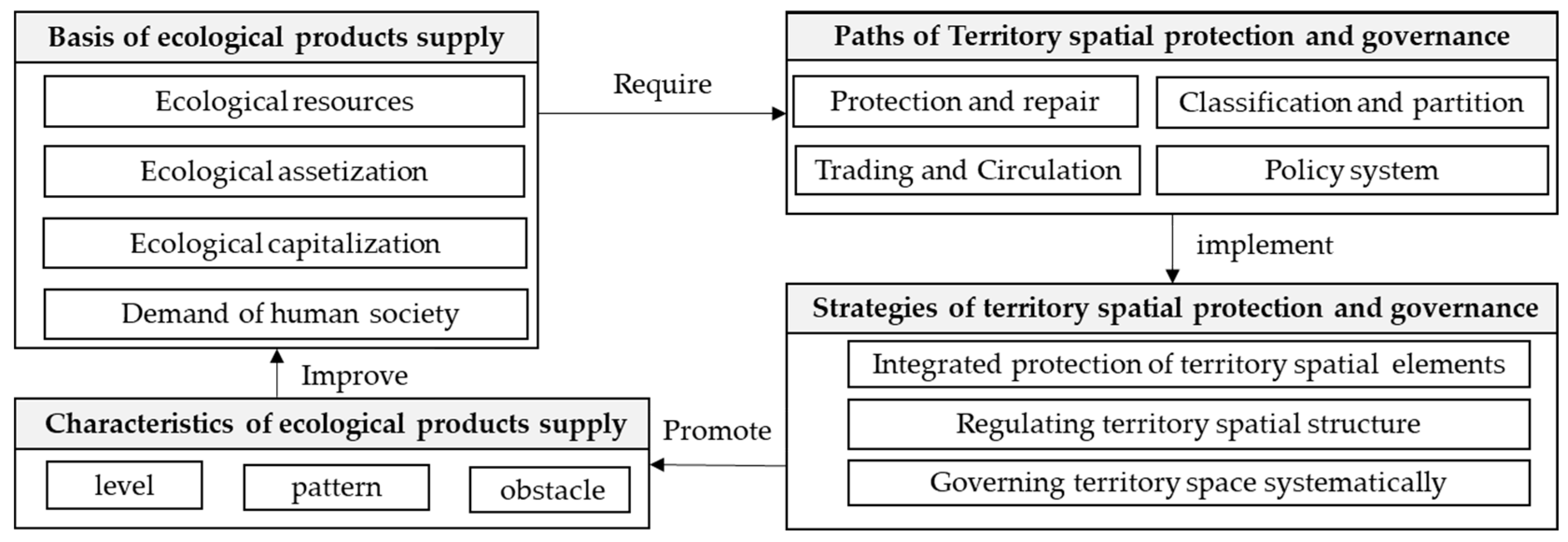
4.1. Integrated Protection of Territorial Spatial Elements for Enhancing the Ecological Products Supply Capacity Level
4.2. Regulation of Territory Spatial Structure based on Differentiated Parrern of Ecological Products Supply Capacity
4.3. Systematic Governance of Territory Space for Addressing the Ecological Products Supply Capacity Obstacle Factors
5. Conclusions
Author Contributions
Funding
Institutional Review Board Statement
Informed Consent Statement
Data Availability Statement
Conflicts of Interest
References
- Gao, L.; Bryan, B.A. Finding Pathways to National-Scale Land-Sector Sustainability. Nature 2017, 544, 217–222. [Google Scholar] [CrossRef] [PubMed]
- Remøy, H.; Street, E. ' The Dynamics of "Post-Crisis" Spatial Planning: A Comparative Study of Office Conversion Policies in England and The Netherlands. Land Use Policy 2018, 77, 811–820. [Google Scholar] [CrossRef]
- Persson, C. Deliberation or Doctrine? Land Use and Spatial Planning for Sustainable Development in Sweden. Land Use Policy 2013, 34, 301–313. [Google Scholar] [CrossRef]
- Turner, B.L.; Lambin, E.F.; Verburg, P.H. From Land-Use/Land-Cover to Land System Science. Ambio 2021. [CrossRef] [PubMed]
- The State Council of the People's Republic of China. Opinions of the Central Committee of the Communist Party of China and the State Council on the Establishment of National Territory Spatial Planning System and Supervision of Its Implementation. Available online: http://www.gov.cn/zhengce/2019-05/23/content_5394187.htm (accessed on 4 May 2021).
- Harris, L.R.; Defeo, O. Sandy Shore Ecosystem Services, Ecological Infrastructure, and Bundles: New Insights and Perspectives. Ecosyst. Serv. 2022, 57, 101477. [Google Scholar] [CrossRef]
- Fan, J.; Sun, W.; Zhou, K.; Chen, D. Major Function Oriented Zone: New Method of Spatial Regulation for Reshaping Regional Development Pattern in China. Chin. Geogr. Sci. 2012, 22, 196–209. [Google Scholar] [CrossRef]
- Woodruff, S.C.; BenDor, T.K. Ecosystem Services in Urban Planning: Comparative Paradigms and Guidelines for High Quality Plans. Landsc. Urban. Plan. 2016, 152, 90–100. [Google Scholar] [CrossRef]
- Hansen, R.; Frantzeskaki, N.; McPhearson, T.; Rall, E.; Kabisch, N.; Kaczorowska, A.; Kain, J.-H.; Artmann, M.; Pauleit, S. The Uptake of the Ecosystem Services Concept in Planning Discourses of European and American Cities. Ecosyst. Serv. 2015, 12, 228–246. [Google Scholar] [CrossRef]
- Hauck, J.; Görg, C.; Varjopuro, R.; Ratamäki, O.; Jax, K. Benefits and Limitations of the Ecosystem Services Concept in Environmental Policy and Decision Making: Some Stakeholder Perspectives. Environ. Sci. Policy. 2013, 25, 13–21. [Google Scholar] [CrossRef]
- Beery, T.; Stålhammar, S.; Jönsson, K.I.; Wamsler, C.; Bramryd, T.; Brink, E.; Ekelund, N.; Johansson, M.; Palo, T.; Schubert, P. Perceptions of the Ecosystem Services Concept: Opportunities and Challenges in the Swedish Municipal Context. Ecosyst. Serv. 2016, 17, 123–130. [Google Scholar] [CrossRef]
- Zorrilla-Miras, P.; Palomo, I.; Gómez-Baggethun, E.; Martín-López, B.; Lomas, P.L.; Montes, C. Effects of Land-Use Change on Wetland Ecosystem Services: A Case Study in the Doñana Marshes (SW Spain). Landsc. Urban. Plan. 2014, 122, 160–174. [Google Scholar] [CrossRef]
- Vallecillo, S.; Polce, C.; Barbosa, A.; Perpiña Castillo, C.; Vandecasteele, I.; Rusch, G.M.; Maes, J. Spatial Alternatives for Green Infrastructure Planning across the EU: An Ecosystem Service Perspective. Landsc. Urban. Plan. 2018, 174, 41–54. [Google Scholar] [CrossRef]
- Plummer, M.L. Assessing Benefit Transfer for the Valuation of Ecosystem Services. Frontiers in Ecol & Environ 2009, 7, 38–45. [Google Scholar]
- Marchese, D.; Reynolds, E.; Bates, M.E.; Morgan, H.; Clark, S.S.; Linkov, I. Resilience and Sustainability: Similarities and Differences in Environmental Management Applications. Sci. Total. Environ. 2018, 613–614, 1275–1283. [Google Scholar] [CrossRef] [PubMed]
- Perschke, M.J.; Harris, L.R.; Sink, K.J.; Lombard, A.T. Using Ecological Infrastructure to Comprehensively Map Ecosystem Service Demand, Flow and Capacity for Spatial Assessment and Planning. Ecosyst. Serv. 2023, 62, 101536. [Google Scholar] [CrossRef]
- Li, L.; Fan, Z.; Xiong, K.; Shen, H.; Guo, Q.; Dan, W.; Li, R. Current Situation and Prospects of the Studies of Ecological Industries and Ecological Products in Eco-Fragile Areas. Environ. Res. 2021, 201, 111613. [Google Scholar] [CrossRef] [PubMed]
- Zhou, J.; Xiong, K.; Wang, Q.; Tang, J.; Lin, L. A Review of Ecological Assets and Ecological Products Supply: Implications for the Karst Rocky Desertification Control. IJERPH 2022, 19, 10168. [Google Scholar] [CrossRef] [PubMed]
- Song, R.; Hu, Y.; Li, M. Chinese Pattern of Urban Development Quality Assessment: A Perspective Based on National Territory Spatial Planning Initiatives. Land. (Basel). 2021, 10, 773. [Google Scholar] [CrossRef]
- Lv, T.; Zeng, C.; Lin, C.; Liu, W.; Cheng, Y.; Li, Y. Towards an Integrated Approach for Land Spatial Ecological Restoration Zoning Based on Ecosystem Health Assessment. Ecol. Indic. 2023, 147, 110016. [Google Scholar] [CrossRef]
- Costanza, R.; de Groot, R.; Braat, L.; Kubiszewski, I.; Fioramonti, L.; Sutton, P.; Farber, S.; Grasso, M. Twenty Years of Ecosystem Services: How Far Have We Come and How Far Do We Still Need to Go? Ecosyst. Serv. 2017, 28, 1–16. [Google Scholar] [CrossRef]
- Wong, C.P.; Jiang, B.; Kinzig, A.P.; Lee, K.N.; Ouyang, Z. Linking Ecosystem Characteristics to Final Ecosystem Services for Public Policy. Ecol Lett 2014, 18, 108–118. [Google Scholar] [CrossRef] [PubMed]
- Shi, Y.; Zhou, C.; Wang, R.; Xu, W. Measuring China's Regional Ecological Development through "EcoDP.". Ecol. Indic. 2012, 15, 253–262. [Google Scholar] [CrossRef]
- Wang, N.; Xu, C.; Kong, F. Value Realization and Protection and governance paths of Forest Ecological Products—Case Study from Zhejiang Province, China. IJERPH 2022, 19, 7538. [Google Scholar] [CrossRef]
- Zhang, Y.; Ma, Z.; Sun, M.; Song, J.; Yang, Y.; Li, Q.; Jing, Y. Quantitatively Evaluating the Ecological Product Value of Nine Provinces in the Yellow River Basin from the Perspective of the Dual-Carbon Strategy. Land. (Basel). 2023, 12, 516. [Google Scholar] [CrossRef]
- Schröter, M.; Barton, D.N.; Remme, R.P.; Hein, L. Accounting for Capacity and Flow of Ecosystem Services: A Conceptual Model and a Case Study for Telemark, Norway. Ecol. Indic. 2014, 36, 539–551. [Google Scholar] [CrossRef]
- Costanza, R.; d’Arge, R.; de Groot, R.; Farber, S.; Grasso, M.; Hannon, B.; Limburg, K.; Naeem, S.; O’Neill, R.V.; Paruelo, J.; et al. The Value of the World's Ecosystem Services and Natural Capital. Nature 1997, 387, 253–260. [Google Scholar] [CrossRef]
- Millennium Ecosystem Assessment (MEA). Ecosystems and Human Well-Being: Synthesis. Isterritory Press.2005.
- Ouyang, Z.; Song, C.; Zheng, H.; Polasky, S.; Xiao, Y.; Bateman, I.J.; Liu, J.; Ruckelshaus, M.; Shi, F.; Xiao, Y.; et al. Using Gross Ecosystem Product (GEP) to Value Nature in Decision Making. Proc Natl Acad Sci USA 2020, 117, 14593–14601. [Google Scholar] [CrossRef]
- van Oudenhoven, A.P.E.; Petz, K.; Alkemade, R.; Hein, L.; de Groot, R.S. Framework for Systematic Indicator Selection to Assess Effects of Land Management on Ecosystem Services. Ecol. Indic. 2012, 21, 110–122. [Google Scholar] [CrossRef]
- de Groot, R.; Brander, L.; van der Ploeg, S.; Costanza, R.; Bernard, F.; Braat, L.; Christie, M.; Crossman, N.; Ghermandi, A.; Hein, L.; et al. Global Estimates of the Value of Ecosystems and Their Services in Monetary Units. Ecosyst. Serv. 2012, 1, 50–61. [Google Scholar] [CrossRef]
- Hein, L.; van Koppen, K.; de Groot, R.S.; van Ierland, E.C. Spatial Scales, Stakeholders and the Valuation of Ecosystem Services. Ecol. Econ. 2006, 57, 209–228. [Google Scholar] [CrossRef]
- Peng, W.; Sun, Y.; Li, Y.; Yuchi, X. An Evaluation and Promotion Strategy of Green Land Use Benefits in China: A Case Study of the Beijing–Tianjin–Hebei Region. Land. (Basel). 2022, 11, 1158. [Google Scholar] [CrossRef]
- Chen, Y.; Zhai, Y.; Gao, J. Spatial Patterns in Ecosystem Services Supply and Demand in the Jing-Jin-Ji Region, China. J. Clean. Prod. 2022, 361, 132177. [Google Scholar] [CrossRef]
- Yang, J.; Huang, X. The 30 m Annual Land Cover Dataset and Its Dynamics in China from 1990 to 2019. Earth Syst. Sci. Data 2021, 13, 3907–3925. [Google Scholar] [CrossRef]
- Farley, J.; Costanza, R. Payments for Ecosystem Services: From Local to Global. Ecol. Econ. 2010, 69, 2060–2068. [Google Scholar] [CrossRef]
- Yang, Y.; Ren, X.; Yan, J. Trade-Offs or Synergies? Identifying Dynamic Land Use Functions and Their Interrelations at the Grid Scale in Urban Agglomeration. Cities 2023, 140, 104384. [Google Scholar]
- Fu, J.; Bu, Z.; Jiang, D.; Lin, G.; Li, X. Sustainable Land Use Diagnosis Based on the Perspective of Production–Living–Ecological Spaces in China. Land Use Policy 2022, 122, 106386. [Google Scholar] [CrossRef]
- Biggs, R.; Schlüter, M.; Biggs, D.; Bohensky, E.L.; BurnSilver, S.; Cundill, G.; Dakos, V.; Daw, T.M.; Evans, L.S.; Kotschy, K.; et al. Toward Principles for Enhancing the Resilience of Ecosystem Services. Annu. Rev. Environ. Resour. 2012, 37, 421–448. [Google Scholar] [CrossRef]
- Xie, G.; Zhang, C.; Zhen, L.; Zhang, L. Dynamic Changes in the Value of China's Ecosystem Services. Ecosyst. Serv. 2017, 26, 146–154. [Google Scholar] [CrossRef]
- Ming, L.; Chang, J.; Li, C.; Chen, Y.; Li, C. Spatial-Temporal Patterns of Ecosystem Services Supply-Demand and Influencing Factors: A Case Study of Resource-Based Cities in the Yellow River Basin, China. IJERPH 2022, 19, 16100. [Google Scholar] [CrossRef]
- Xie, H.; Zhu, Z.; Li, Z. Spatial Divergence Analysis of Ecosystem Service Value in Hilly Mountainous Areas: A Case Study of Ruijin City. Land. (Basel). 2022, 11, 768. [Google Scholar] [CrossRef]
- Xie, G.D.; Lu, C.X.; Long, Y.F.; Zheng, D. ; Li SC; Ecological assets valuation in the Tibetan Plateau. J. Nat. Resour. 2003, 2, 189–196. (In Chinese) [Google Scholar]
- Xu, H.; Jia, A.; Song, X.; Bai, Y. Suitability Evaluation of Carrying Capacity and Utilization Patterns on Tidal Flats of Bohai Rim in China. J. Environ. Manag. 2022, 319, 115688. [Google Scholar] [CrossRef] [PubMed]
- Guo, D.; Wang, D.; Zhong, X.; Yang, Y.; Jiang, L. Spatiotemporal Changes of Land Ecological Security and Its Obstacle Indicators Diagnosis in the Beijing–Tianjin–Hebei Region. Land. (Basel). 2021, 10, 706. [Google Scholar] [CrossRef]
- Wei, L.; Zhang, Y.; Wang, L.; Cheng, Z.; Wu, X. Obstacle Indicators Diagnosis and Advantage Functions Zoning Optimization Based on "Production-Living-Ecological" Functions of National Territory Space in Jilin Province. Sustainability 2022, 14, 4215. [Google Scholar] [CrossRef]
- Han, H.; Guo, L.; Zhang, J.; Zhang, K.; Cui, N. Spatiotemporal Analysis of the Coordination of Economic Development, Resource Utilization, and Environmental Quality in the Beijing-Tianjin-Hebei Urban Agglomeration. Ecol. Indic. 2021, 127, 107724. [Google Scholar] [CrossRef]
- Yang, Y. Evolution of Habitat Quality and Association with Land-Use Changes in Mountainous Areas: A Case Study of the Taihang Mountains in Hebei Province, China. Ecol. Indic. 2021, 129, 107967. [Google Scholar] [CrossRef]
- Wang, Z.; Liang, L.; Sun, Z.; Wang, X. Spatiotemporal Differentiation and the Factors Influencing Urbanization and Ecological Environment Synergistic Effects within the Beijing-Tianjin-Hebei Urban Agglomeration. J. Environ. Manag. 2019, 243, 227–239. [Google Scholar] [CrossRef] [PubMed]
- Yang, Y.; Bao, W.; Liu, Y. Coupling Coordination Analysis of Rural Production-Living-Ecological Space in the Beijing-Tianjin-Hebei Region. Ecol. Indic. 2020, 117, 106512. [Google Scholar] [CrossRef]
- Smith, A.; Yee, S.H.; Russell, M.; Awkerman, J.; Fisher, W.S. Linking Ecosystem Service Supply to Stakeholder Concerns on Both Land and Sea: An Example from Guánica Bay Watershed, Puerto Rico. Ecol. Indic. 2017, 74, 371–383. [Google Scholar] [CrossRef]
- Zhou, W.; Xi, Y.; Zhai, L.; Li, C.; Li, J.; Hou, W. Zoning for Spatial Conservation and Restoration Based on Ecosystem Services in Highly Urbanized Region: A Case Study in Beijing-Tianjin-Hebei, China. Land. (Basel). 2023, 12, 733. [Google Scholar] [CrossRef]
- Bao, C.; Wang, H.; Sun, S. Comprehensive Simulation of Resources and Environment Carrying Capacity for Urban Agglomeration: A System Dynamics Approach. Ecol. Indic. 2022, 138, 108874. [Google Scholar] [CrossRef]
- Wu, F.; Wang, X.; Ren, Y. Urbanization's Impacts on Ecosystem Health Dynamics in the Beijing-Tianjin-Hebei Region, China. IJERPH 2021, 18, 918. [Google Scholar] [CrossRef] [PubMed]
- Pacione, M. Private Profit, Public Interest and Land Use Planning—A Conflict Interpretation of Residential Development Pressure in Glasgow's Rural–Urban Fringe. Land Use Policy 2013, 32, 61–77. [Google Scholar] [CrossRef]
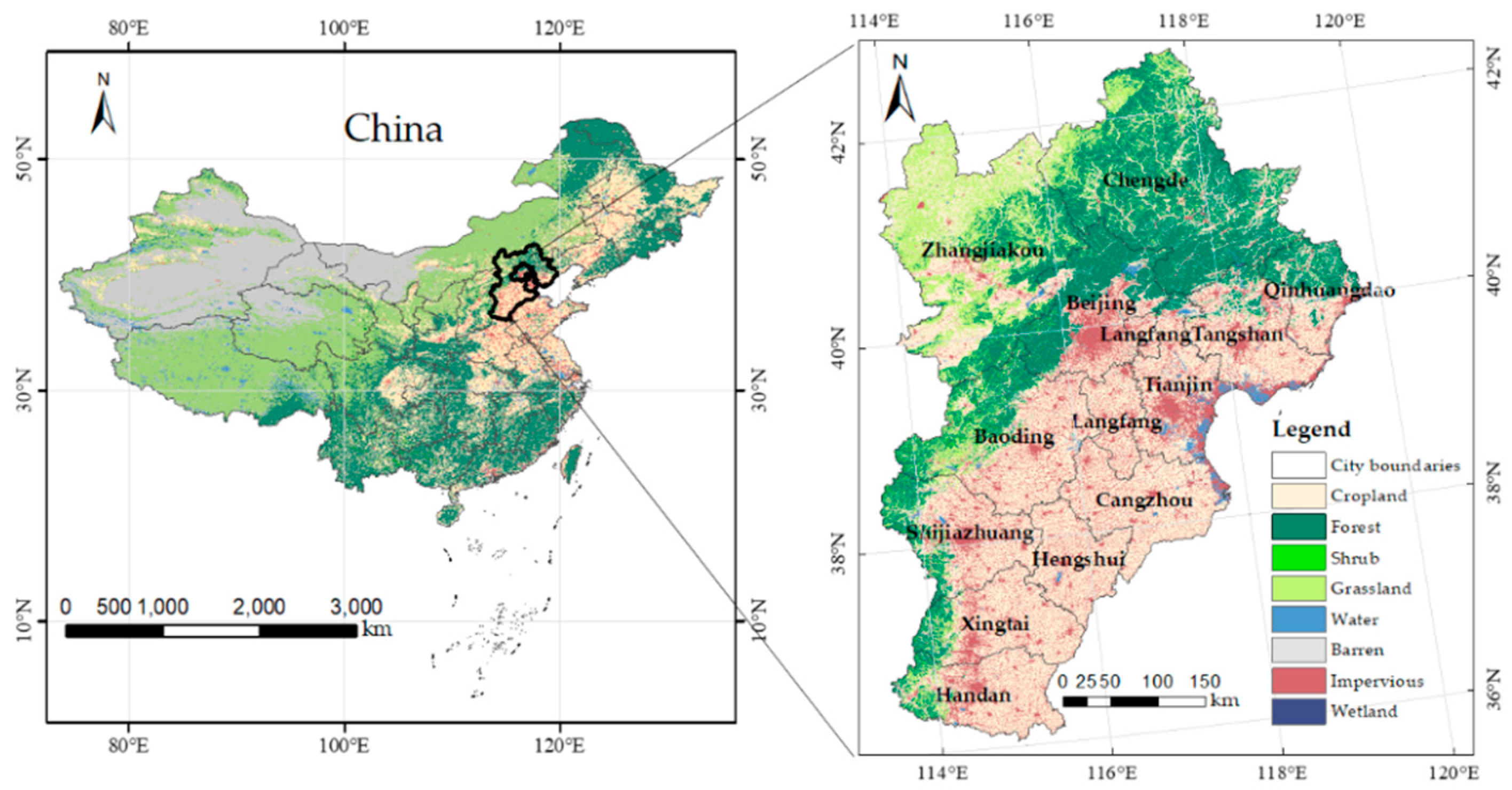
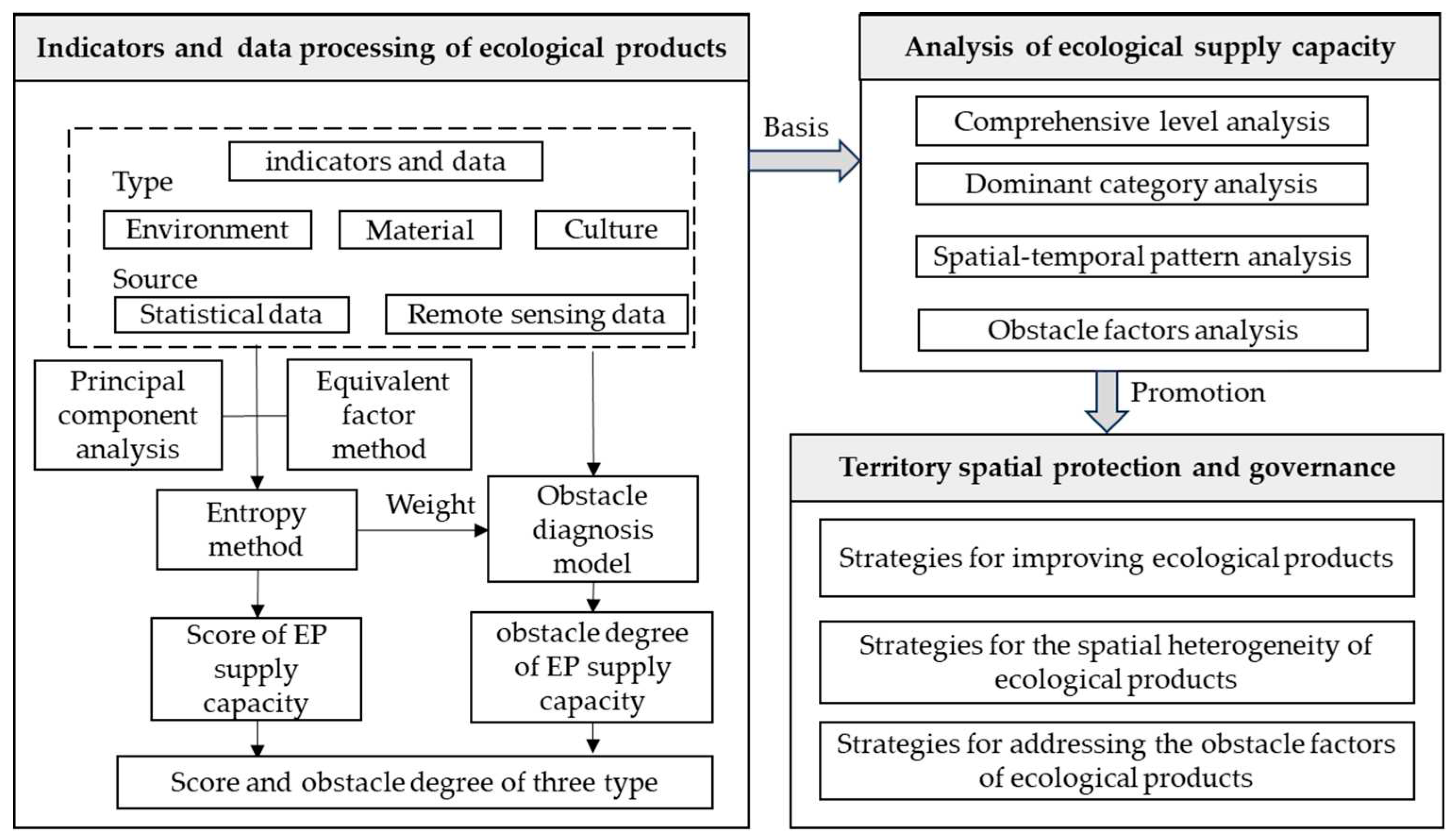
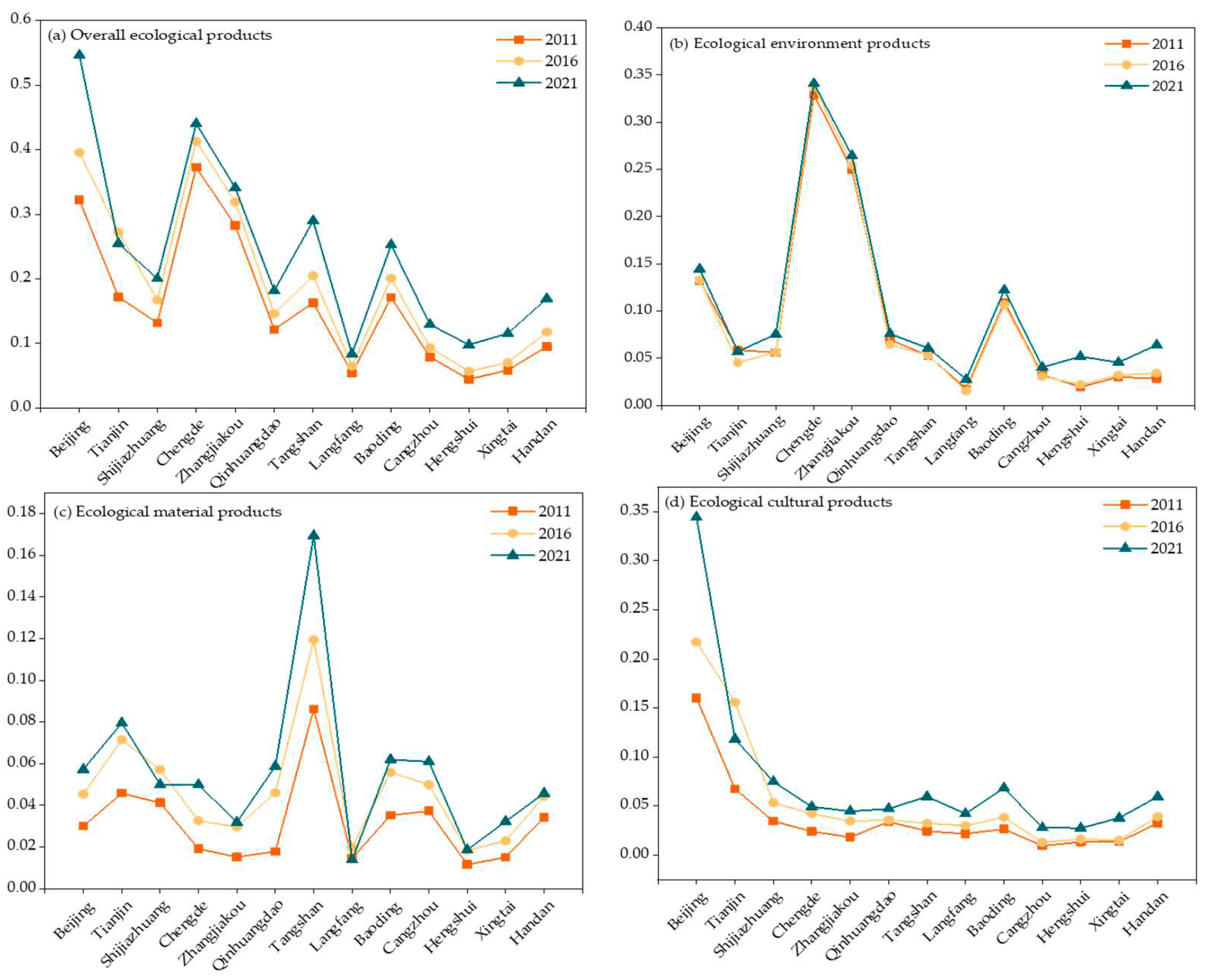
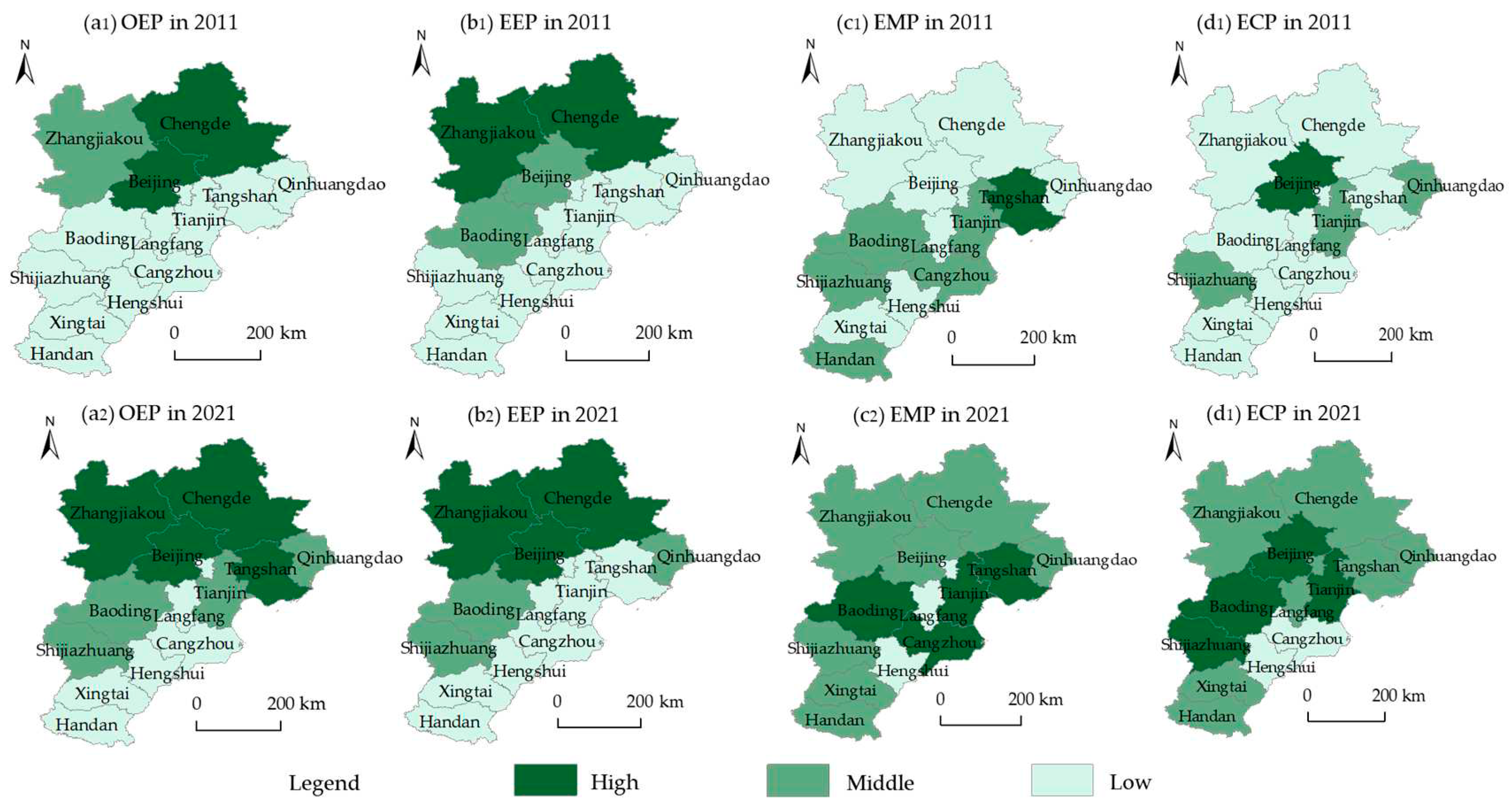
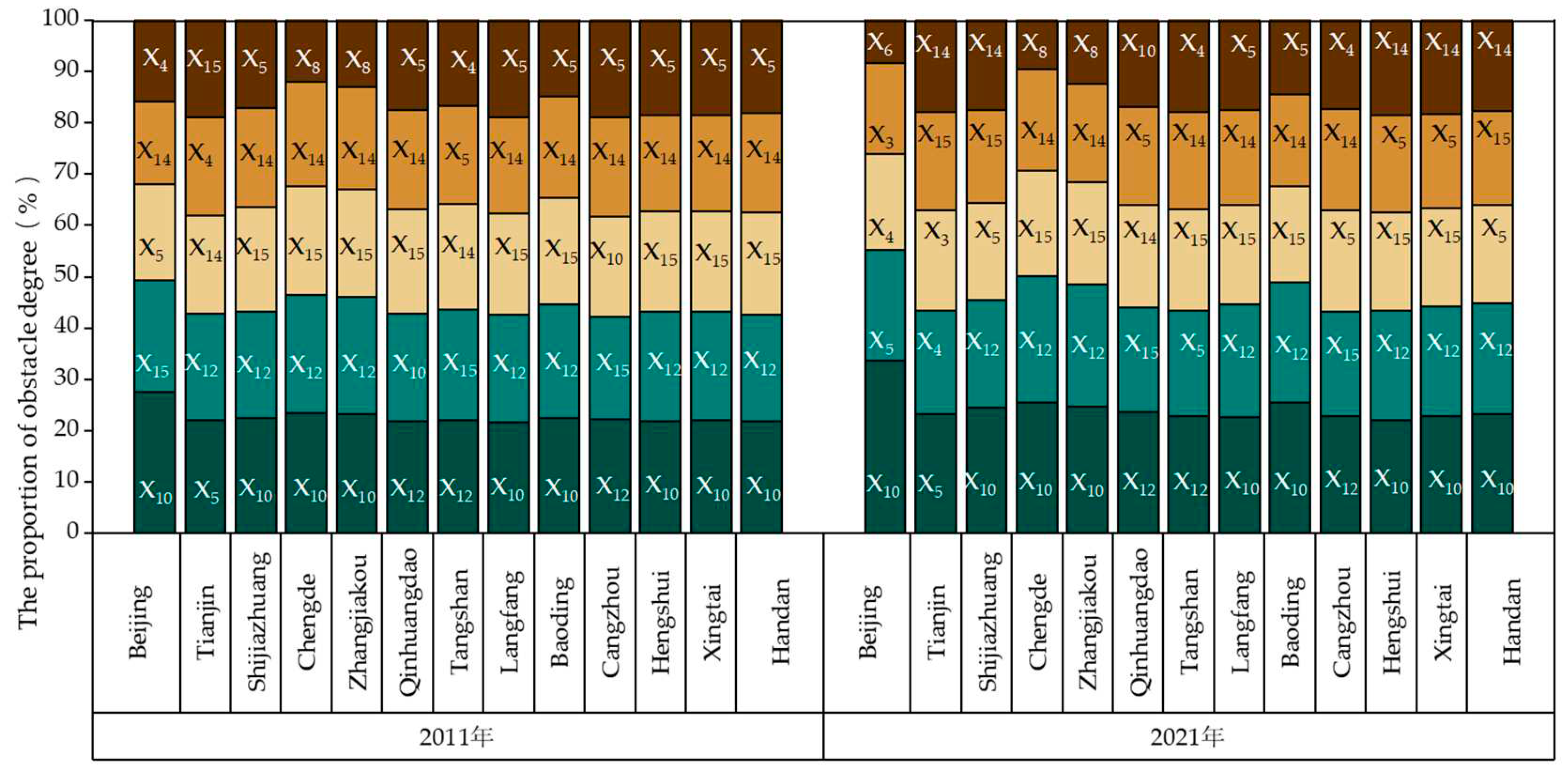
| Data Source | Data format | Data support organization |
|---|---|---|
| The 30m annual China land cover dataset (CLCD) 2011-2022 | Raster data | Wuhan University |
| Statistical Yearbook of the provinces in the BTH region China Urban Statistical Yearbook National Compilation of Cost and Benefit of Agricultural Products |
Numerical data | National Bureau of Statistics of the People's Republic of China |
| Ecological Environment Bulletin of provinces and cities in the BTH region | Numerical data | Ecological Environment Bureau of provinces and cities in the BTH region |
| Target layer | Criterion Layer | Factor layer | Index layer | Weight | Direction | |
|---|---|---|---|---|---|---|
| Ecological product | Ecological environmental products | X1 Fresh air X2 Clean water X3 Safe soil |
The overall level of air | 0.0191 | + | |
| The overall level of water | 0.0513 | + | ||||
| Soil conservation value(CNY) | 0.0885 | + | ||||
| X4 Biodiversity X5 Eco-land X6 Per capita cropland |
Biodiversity value(CNY) | 0.0933 | + | |||
| Ecological land area (hectares) | 0.1054 | + | ||||
| Cultivated area per capita (square meters/person) |
0.0303 | + | ||||
| Ecological material products | X7 Agricultural products X8 Forestry products X9 Animal husbandry products X10 Fishery products |
Output value of agricultural products (CNY) | 0.0249 | + | ||
| Output value of forest products (CNY) | 0.0722 | + | ||||
| Output value of animal husbandry products (CNY) |
0.0227 | + | ||||
| Output value of fishery products (CNY) | 0.1232 | + | ||||
| Biomass energy Wind energy Solar energy Hydro energy |
Biomass energy output value | \ | + | |||
| Wind energy output value | \ | + | ||||
| Solar energy output value | \ | + | ||||
| Hydroenergy output value | \ | + | ||||
| Ecological cultural products | X11 Greening of the built-up area X12 Park green space X13 Forest cover |
Greening rate of built-up areas (%) | 0.0171 | + | ||
| Area of park green space (ha) | 0.1216 | + | ||||
| Forest coverage (%) | 0.0150 | + | ||||
| X14 Eco-tourism X15 Eco-leisure |
Tourist excursion income (CNY) | 0.1060 | + | |||
| Tourist entertainment income(CNY) | 0.1100 | + | ||||
| Type | Cropland | Woodland | Grassland | Water | Wetland | Bare land |
|---|---|---|---|---|---|---|
| Soil safety | 0.437 | 1.949 | 1.235 | 0.781 | 1.940 | 0.017 |
| Biodiversity | 0.143 | 1.781 | 1.126 | 2.142 | 6.611 | 0.017 |
| Index | Year | ||||||||||
|---|---|---|---|---|---|---|---|---|---|---|---|
| Type | 2011 | 2012 | 2013 | 2014 | 2015 | 2016 | 2017 | 2018 | 2019 | 2020 | 2021 |
| OEP | 1.591 | 1.646 | 1.715 | 1.788 | 1.787 | 1.941 | 1.999 | 2.149 | 2.287 | 2.117 | 2.386 |
| EEP | 0.912 | 0.900 | 0.888 | 0.882 | 0.890 | 0.913 | 0.926 | 0.947 | 0.974 | 1.028 | 1.055 |
| EMP | 0.310 | 0.370 | 0.429 | 0.461 | 0.452 | 0.471 | 0.416 | 0.476 | 0.489 | 0.543 | 0.561 |
| ECP | 0.369 | 0.376 | 0.398 | 0.445 | 0.445 | 0.556 | 0.658 | 0.727 | 0.824 | 0.545 | 0.770 |
Disclaimer/Publisher’s Note: The statements, opinions and data contained in all publications are solely those of the individual author(s) and contributor(s) and not of MDPI and/or the editor(s). MDPI and/or the editor(s) disclaim responsibility for any injury to people or property resulting from any ideas, methods, instructions or products referred to in the content. |
© 2023 by the authors. Licensee MDPI, Basel, Switzerland. This article is an open access article distributed under the terms and conditions of the Creative Commons Attribution (CC BY) license (http://creativecommons.org/licenses/by/4.0/).




